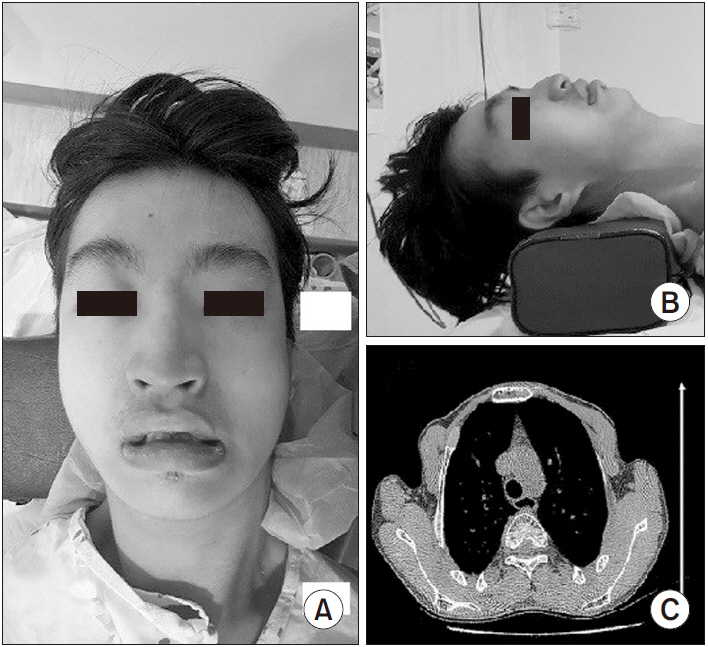Anesth Pain Med.
2020 Jan;15(1):120-123. 10.17085/apm.2020.15.1.120.
Anesthetic considerations for an adult with Wolf- Hirschhorn syndrome - A case report -
- Affiliations
-
- 1Department of Anesthesia and Pain Medicine, Pusan National University Yangsan Hospital, Korea
- 2Department of Dental Anesthesia and Pain Medicine, Pusan National University Dental Hospital, Yangsan, Korea
- KMID: 2500465
- DOI: http://doi.org/10.17085/apm.2020.15.1.120
Abstract
- Background
Wolf-Hirschhorn syndrome (WHS) includes features such as growth restriction, mental retardation, congenital heart disease, convulsions as well as microcephaly and micrognathia. Thus, the anesthesiologists may have difficulties in airway management, neuromuscular relaxation, and in maintaining hemodynamic stability. Case: A 24-year-old man with WHS underwent surgery for closed reduction and internal fixation of the right neck of femur. His face showed features typical of patients with WHS such as a prominent glabella, hypertelorism, micrognathia, low-set malformed ears, and a down-turned mouth. Since difficult airway management was expected, a video-assisted laryngoscope was used for successful intubation. The surgery terminated without any problems under total intravenous anesthesia.
Conclusions
A patient with WHS may have a variety of problems. Therefore, through careful evaluation of the airway, cardiovascular system, and cerebral nervous system and by making an appropriate anesthetic plan, anesthesiologists can perform a safe general anesthesia in patients with WHS.
Keyword
Figure
Reference
-
Paradowska-Stolarz AM. 2014. Wolf-Hirschhorn syndrome (WHS) - literature review on the features of the syndrome. Adv Clin Exp Med. 23:485–9. DOI: 10.17219/acem/24111. PMID: 24979523.Bösenberg AT. 2007. Anaesthesia and Wolf-Hirschhorn syndrome. South Afr J Anaesth Analg. 13:31–4. DOI: 10.1080/22201173.2007.10872488.Ginsburg R., Purcell-Jones G. 1988. Malignant hyperthermia in the Wolf-Hirschhorn syndrome. Anaesthesia. 43:386–8. DOI: 10.1111/j.1365-2044.1988.tb09019.x. PMID: 3400848.Choi JH., Kim JH., Park YC., Kim WY., Lee YS. 2011. Anesthetic experience using total intra-venous anesthesia for a patient with Wolf-Hirschhorn syndrome -a case report-. Korean J Anesthesiol. 60:119–23. DOI: 10.4097/kjae.2011.60.2.119. PMID: 21390167. PMCID: PMC3049879.Mohiuddin S., Mayhew JF. 2005. Anesthesia for children with Wolf-Hirshhorn syndrome: a report and literature review. Paediatr Anaesth. 15:254–5. DOI: 10.1111/j.1460-9592.2005.01419.x. PMID: 15725327.Iacobucci T., Nanni L., Picoco F., de Francisci G G. 2004. Anesthesia for a child with Wolf-Hirshhorn syndrome. Paediatr Anaesth. 14:969. DOI: 10.1111/j.1460-9592.2004.01438.x. PMID: 15500501.Tsukamoto M., Yamanaka H., Yokoyama T. 2017. Anesthetic considerations for a pediatric patient with Wolf-Hirschhorn syndrome: a case report. J Dent Anesth Pain Med. 17:231–3. DOI: 10.17245/jdapm.2017.17.3.231. PMID: 29090255. PMCID: PMC5647821.Humston C., Bernard R., Khan S., Tobias JD. 2016. Perioperative care of an infant with Wolf-Hirschhorn syndrome: is there a risk of malignant hyperthermia. J Med Cases. 7:126–9. DOI: 10.14740/jmc2418w.Azar I. 1984. The response of patients with neuromuscular disorders to muscle relaxants: a review. Anesthesiology. 61:173–87. DOI: 10.1097/00000542-198408000-00011. PMID: 6087697.
- Full Text Links
- Actions
-
Cited
- CITED
-
- Close
- Share
- Similar articles
-
- Anesthetic considerations for a pediatric patient with Wolf-Hirschhorn syndrome: a case report
- A Case of Wolf-Hirschhorn Syndrome with Long Term Survival Diagnosed by Fluorescent In-situ Hybridization (FISH)
- Prenatal diagnosis of 4p deletion syndrome: A case series report
- A Case of Wolf-Hirschhorn Syndrome with Periventricular Nodular Heterotopia Presenting with Status Epilepticus
- Anesthetic experience using total intra-venous anesthesia for a patient with Wolf-Hirschhorn syndrome: A case report


